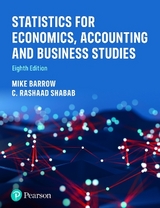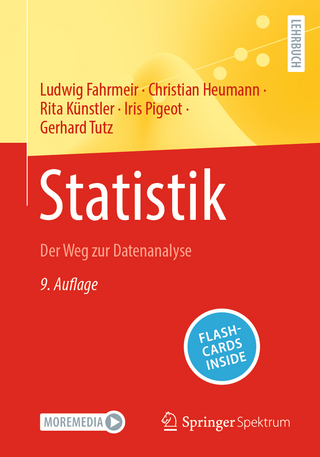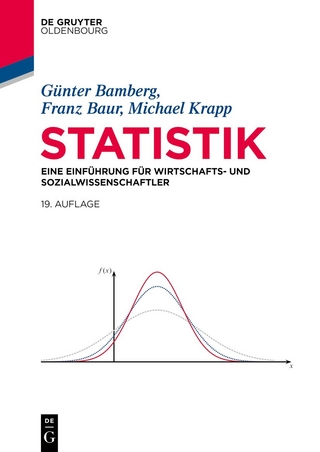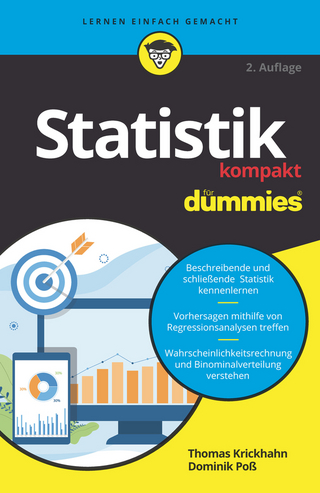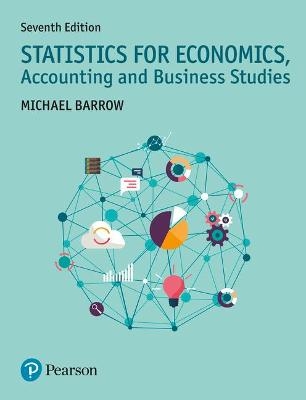
Statistics for Economics, Accounting and Business Studies
Pearson Education Limited (Verlag)
978-1-292-11870-3 (ISBN)
- Titel erscheint in neuer Auflage
- Artikel merken
Increase your confidence in Statistics and build up your skills for excellence with this reader-friendly guide to the field. Statistics for Economics, Accounting, and Business Studies, 7th Edition by Michael Barrow is a user-friendly, comprehensive introduction to the subject, offering a variety of statistical tools and techniques that will help you build your skills and knowledge in Mathematics and Economics.
Ideal for students of economics and the closely related disciplines of accountancy, finance, and business, this is an easy-to-follow text that does not require prior knowledge of Statistics. The book guides you through the essential principles of the field and provides a thorough analysis of statistical concepts and methods.
This latest edition will offer you new and updated content regarding topics, such as statistical reports, graphs, and hypothesis testing. The text also includes updates to demonstrate recent examples and real-life data.
With a plethora of features to support, practice, and test your understanding of the discipline, this essential learning resource will help you solve real-life economic problems, providing an insight into the relationship between statistical techniques and relevant concepts.
Michael Barrow is a Senior Lecturer in Economics at the University of Sussex. He has acted as a consultant for major, industrial, commercial and government bodies
Preface to the fourth edition Introduction
Descriptive statistics
Learning outcomes
Introduction
Summarising data using graphical techniques
Looking at cross-section data: wealth in the UK in 2005
Summarising data using numerical techniques
The box and whiskers diagram
Time-series data: investment expenditures 1977–2009
Graphing bivariate data: the scatter diagram
Data transformations
The information and data explosion
Writing statistical reports
Guidance to the student: how to measure your progress
Chapter summary
Key terms and concepts
Problems
Answers to Exercises
Appendix 1A: S notation
Problems on S notation
Appendix 1B: E and V operators
Appendix 1C: Using logarithms
Problems on logarithms
References
Probability
Learning outcomes
Probability theory and statistical inference
The definition of probability
Probability theory: the building blocks
Bayes’ theorem
Decision analysis
Chapter summary
Key terms and concepts
Problems
Answers to Exercises
Probability distributions
Learning outcomes
Introduction
Random variables
The Binomial distribution
The Normal distribution
The distribution of the sample mean
The relationship between the Binomial and Normal distributions
The Poisson distribution
Chapter summary
Key terms and concepts
Problems
Answers to Exercises
Estimation and confidence intervals
Learning outcomes
Introduction
Point and interval estimation
Rules and criteria for finding estimates
Estimation with large samples
Precisely what is a confidence interval?
Estimation with small samples: the t distribution
Chapter summary
Key terms and concepts
Problems
Answers to Exercises
Appendix: Derivations of sampling distributions
Hypothesis testing
Learning outcomes
Introduction
The concepts of hypothesis testing
The Prob-value approach
Significance, effect size and power
Further hypothesis tests
Hypothesis tests with small samples
Are the test procedures valid?
Hypothesis tests and confidence intervals
Independent and dependent samples
Issues with hypothesis testing
Chapter summary
Key terms and concepts
Problems
Answers to Exercises
The c2 and F distributions
Learning outcomes
Introduction
The c2 distribution
The F distribution
Analysis of variance
Chapter summary
Key terms and concepts
Problems
Answers to Exercises
Appendix: Use of c2 and F distribution tables
Correlation and regression
Learning outcomes
Introduction
What determines the birth rate in developing countries?
Correlation
Regression analysis
Inference in the regression model
Chapter summary
Key terms and concepts
Problems
Answers to Exercises
References
Multiple regression
Learning outcomes
Introduction
Principles of multiple regression
What determines imports into the UK?
Finding the right model
Chapter summary
Key terms and concepts
Problems
Answers to Exercises
References
Data collection and sampling methods
Learning outcomes
Introduction
Using secondary data sources
Collecting primary data
Random sampling
Calculating the required sample size
Collecting the sample
Case study: the UK Living Costs and Food Survey
Chapter summary
Key terms and concepts
Problems
References
Index numbers
Learning outcomes
Introduction
A simple index number
A price index with more than one commodity
Using expenditures as weights
Quantity and expenditure indices
The Consumer Price Index
Discounting and present values
Inequality indices
The Lorenz curve
The Gini coefficient
Concentration ratios
Chapter summary
Key terms and concepts
Problems
Answers to Exercises
Appendix: deriving the expenditure share form of the
Laspeyres price index
References
Seasonal adjustment of time series data
Learning outcomes
Introduction
The components of a time series
Isolating the trend
Isolating seasonal factors
Seasonal adjustment
An alternative method for finding the trend
Forecasting
Further issues
Chapter summary
Key terms and concepts
Problems
Answers to Exercises
List of important formulae Appendix: Tables Answers to problems Index
| Erscheinungsdatum | 09.02.2017 |
|---|---|
| Verlagsort | Harlow |
| Sprache | englisch |
| Maße | 190 x 245 mm |
| Gewicht | 940 g |
| Themenwelt | Mathematik / Informatik ► Mathematik ► Statistik |
| Wirtschaft ► Betriebswirtschaft / Management ► Allgemeines / Lexika | |
| Wirtschaft ► Betriebswirtschaft / Management ► Rechnungswesen / Bilanzen | |
| Wirtschaft ► Volkswirtschaftslehre ► Ökonometrie | |
| ISBN-10 | 1-292-11870-9 / 1292118709 |
| ISBN-13 | 978-1-292-11870-3 / 9781292118703 |
| Zustand | Neuware |
| Informationen gemäß Produktsicherheitsverordnung (GPSR) | |
| Haben Sie eine Frage zum Produkt? |
aus dem Bereich
